
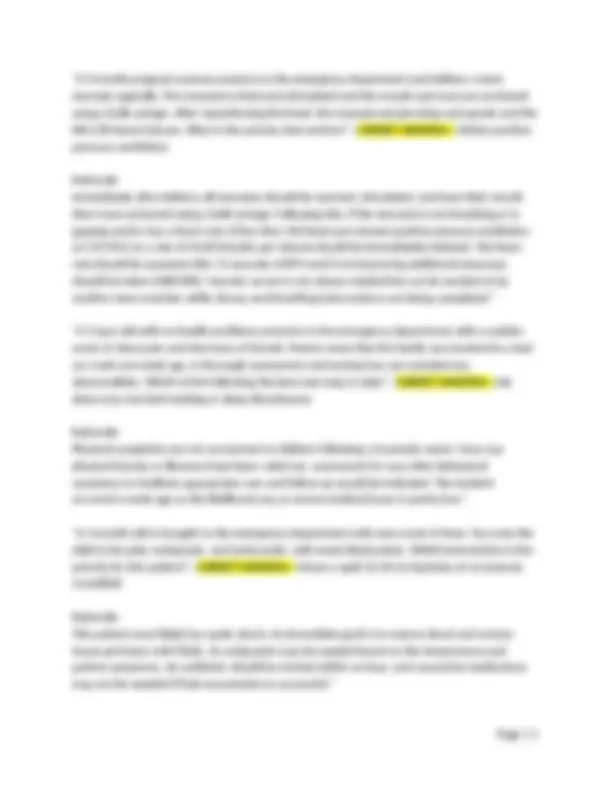
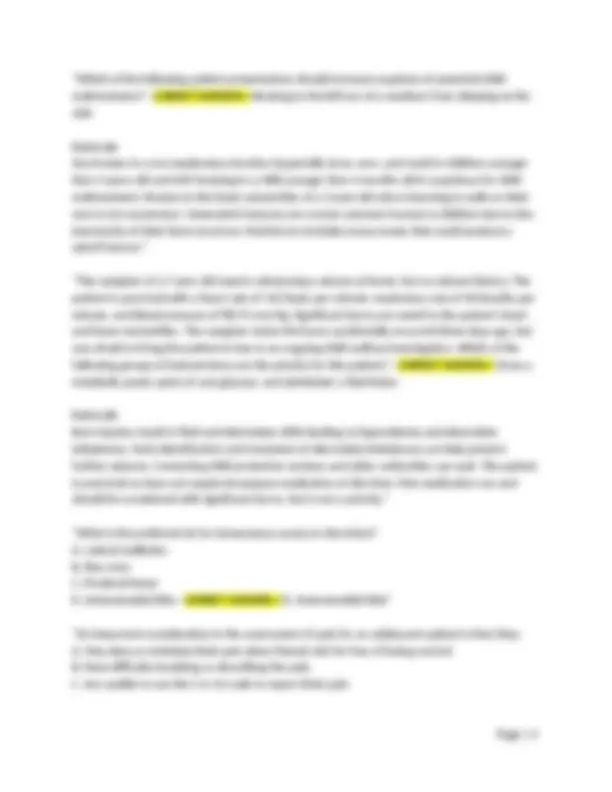
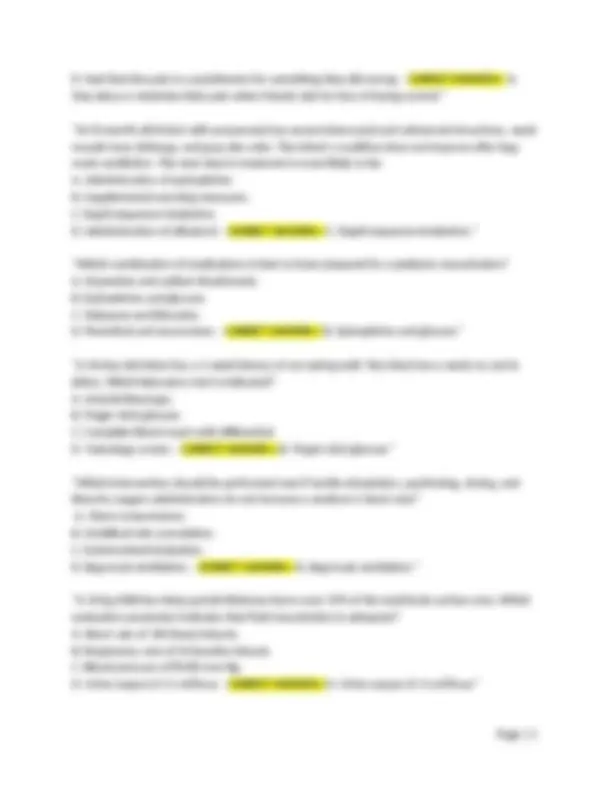
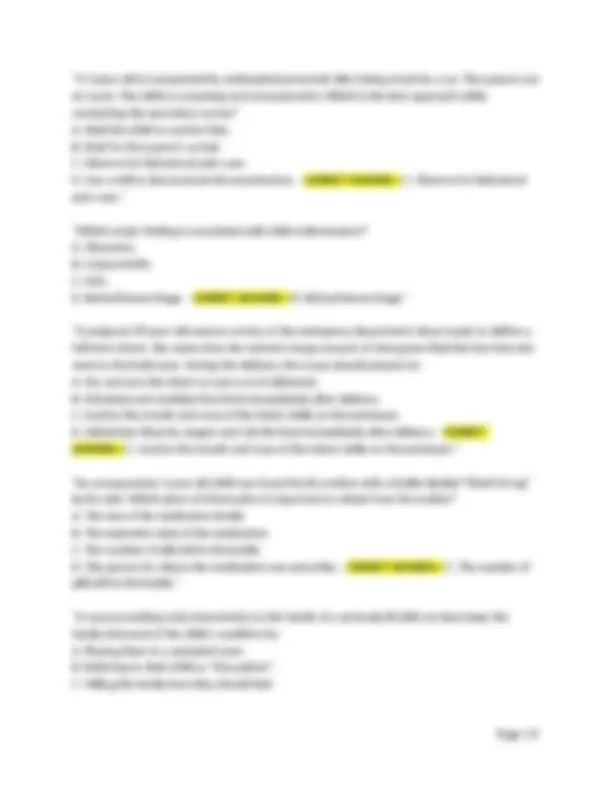
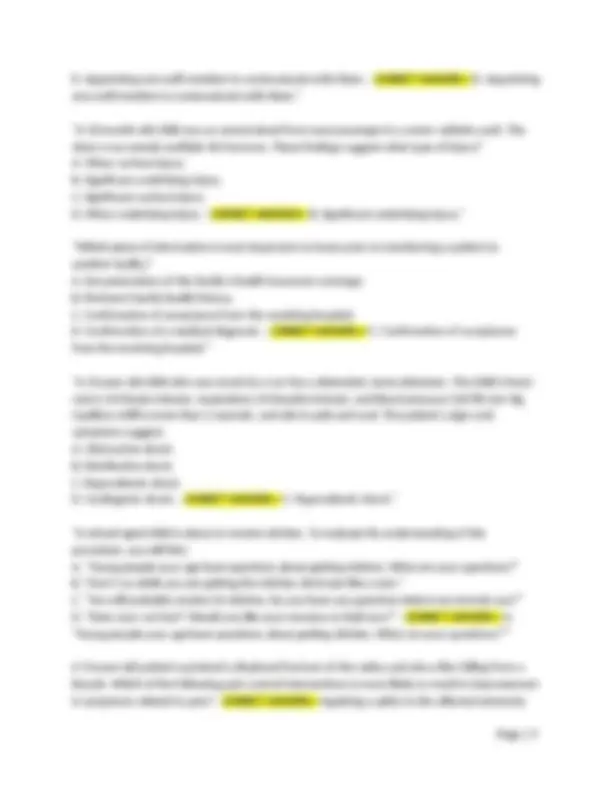
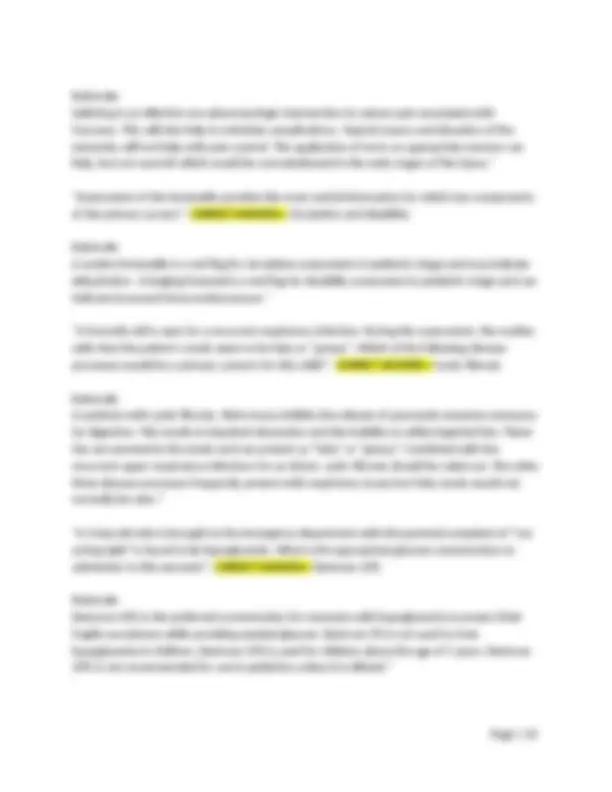
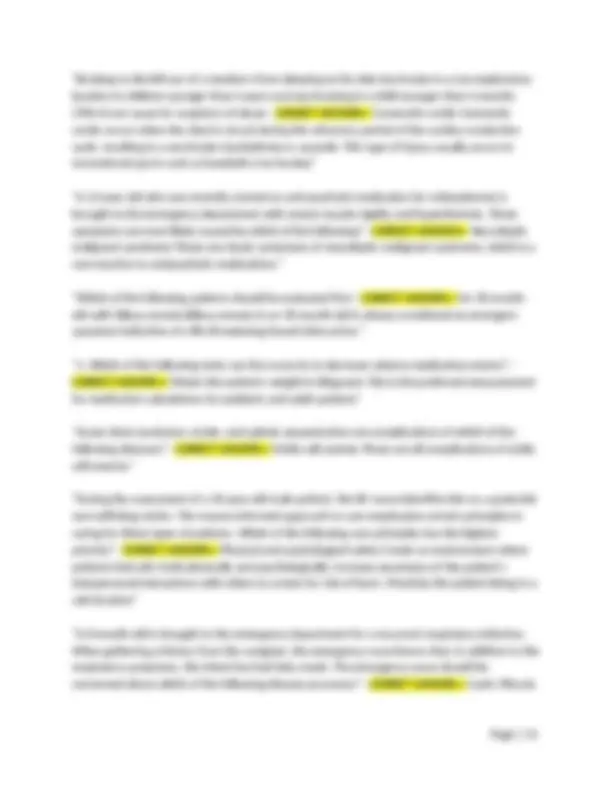
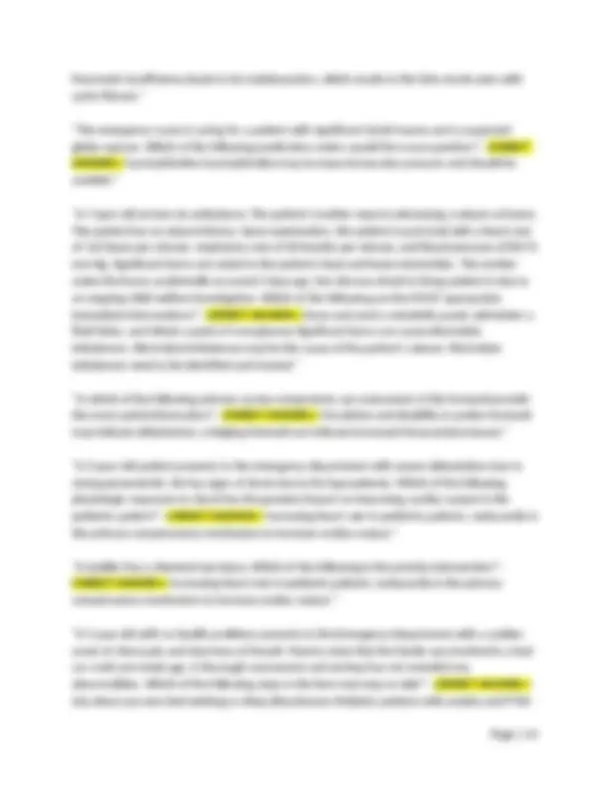
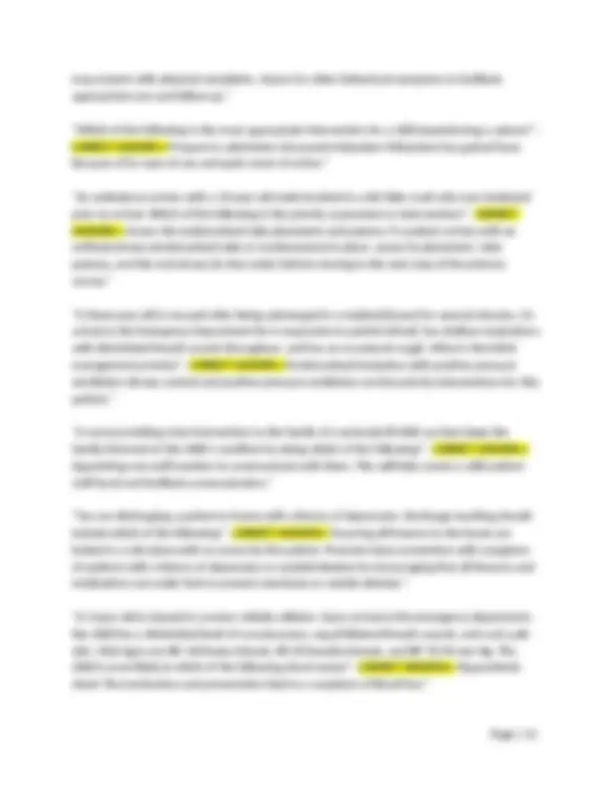
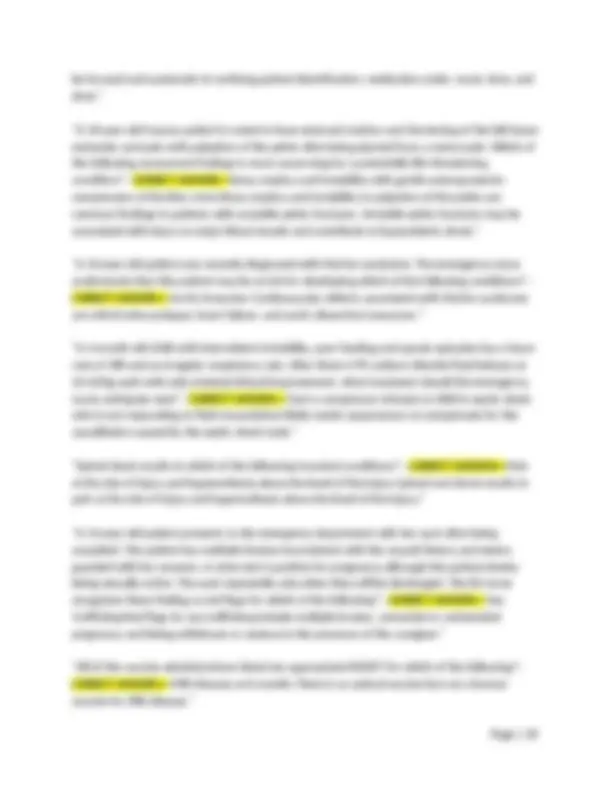
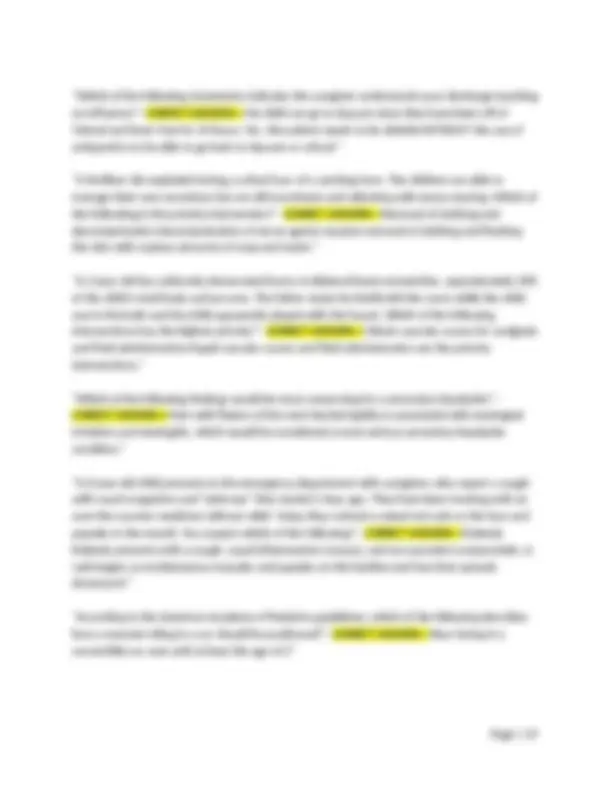
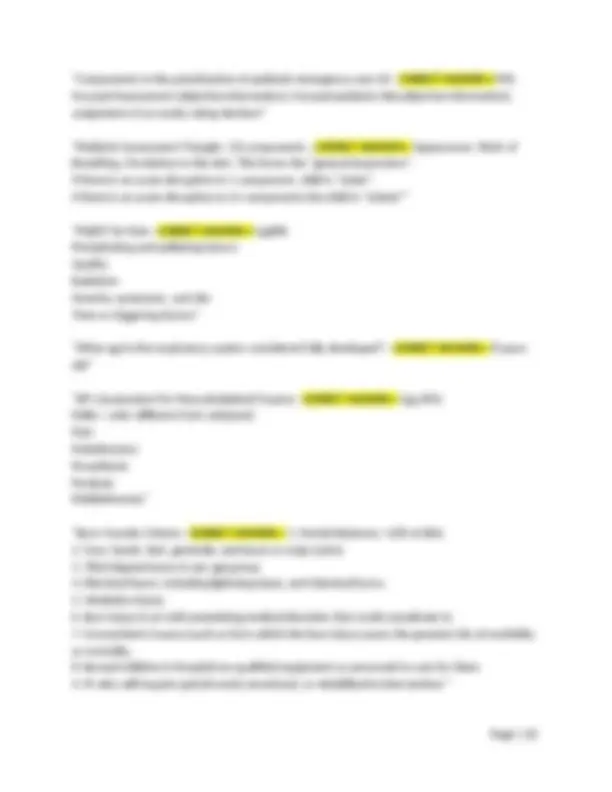
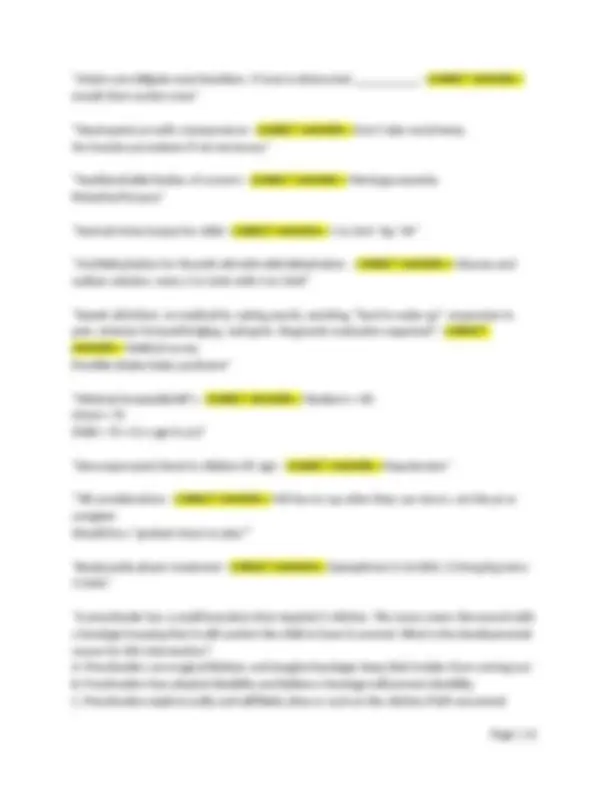
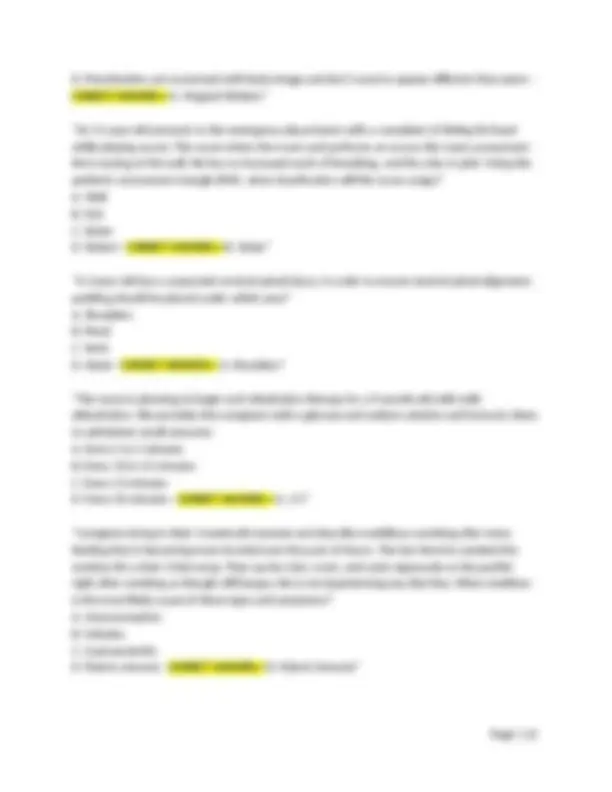
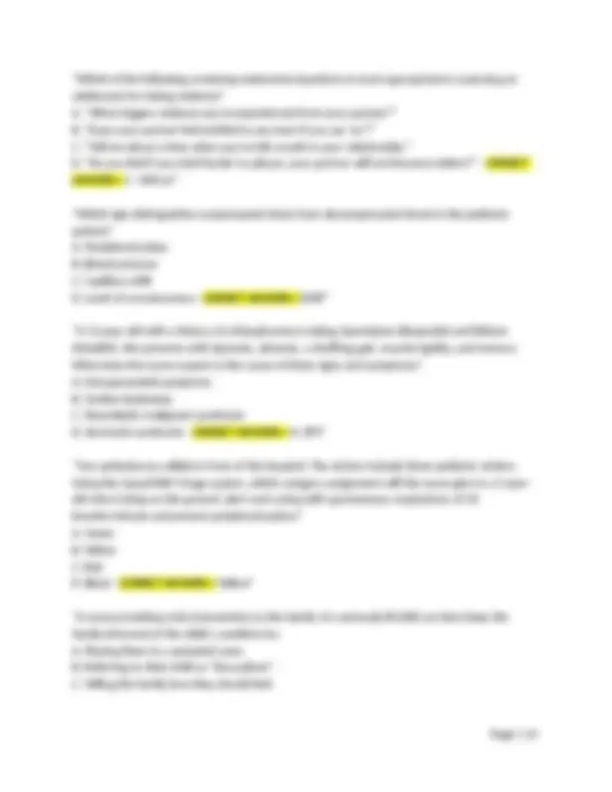
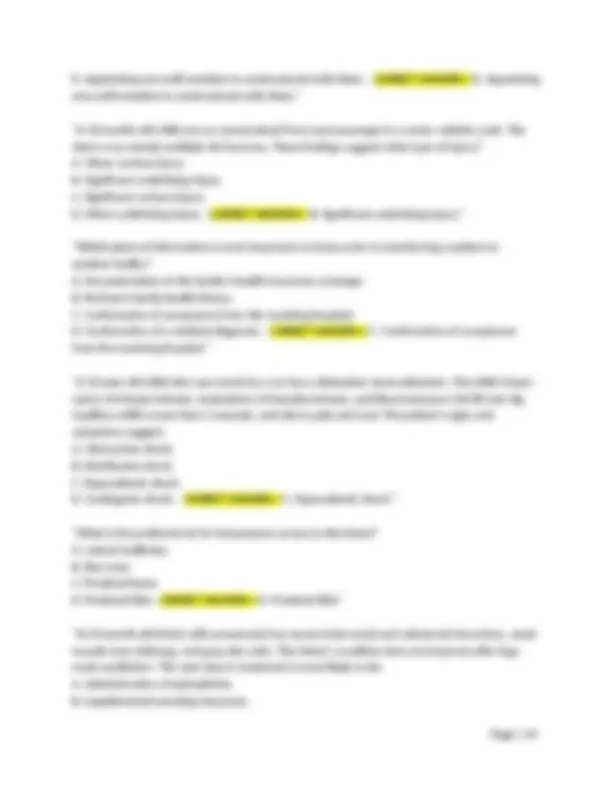
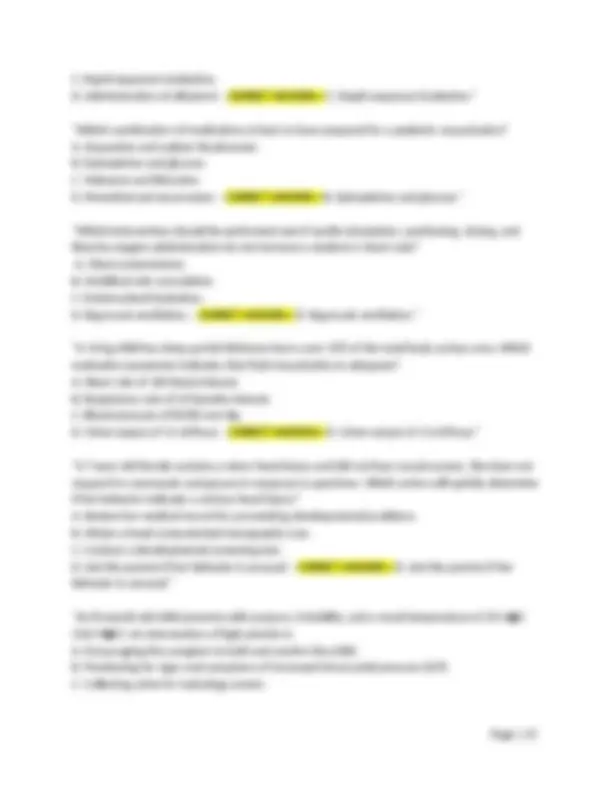
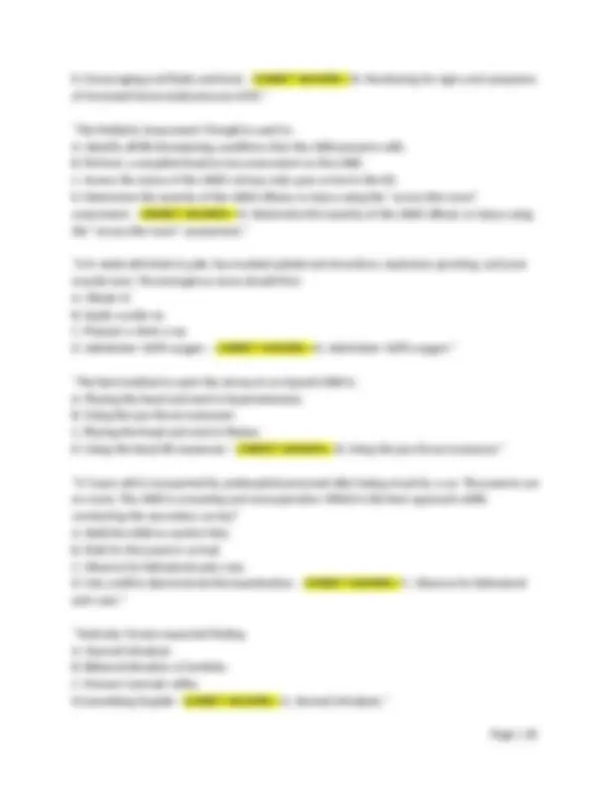



Study with the several resources on Docsity

Earn points by helping other students or get them with a premium plan


Prepare for your exams
Study with the several resources on Docsity

Earn points to download
Earn points by helping other students or get them with a premium plan
Community
Ask the community for help and clear up your study doubts
Discover the best universities in your country according to Docsity users
Free resources
Download our free guides on studying techniques, anxiety management strategies, and thesis advice from Docsity tutors
"A nurse providing trauma informed care to the family of a seriously ill child should be doing which of the following? - CORRECT ANSWER=> Appointing one staff member to stay with the family Rationale Caregivers experiencing the crisis of a critically ill child have low attentiveness and increased stress so would benefit from having a member of the healthcare team to stay with them as much as possible and communicate updates on the plan of care. Caregivers should be allowed to stay with their child as much as possible and not placed in a secluded room away for them."
Typology: Exams
1 / 27

This page cannot be seen from the preview
Don't miss anything!




















"A nurse providing trauma informed care to the family of a seriously ill child should be doing which of the following? - CORRECT ANSWER=> Appointing one staff member to stay with the family Rationale Caregivers experiencing the crisis of a critically ill child have low attentiveness and increased stress so would benefit from having a member of the healthcare team to stay with them as much as possible and communicate updates on the plan of care. Caregivers should be allowed to stay with their child as much as possible and not placed in a secluded room away for them." "What is the priority intervention for symptomatic bradycardia in a four-year-old child? - CORRECT ANSWER=> Initiate bag-mask ventilation Rationale Identifying and treating other causes, chest compressions, and epinephrine are interventions for pediatric bradycardia with signs of poor perfusion that are not improved by adequate oxygenation and ventilation. Atropine and pacing may be considered if there is no response to the other interventions." "A three-year-old is rescued after being submerged in a pool for several minutes. On arrival the patient is responsive to painful stimuli with shallow respirations, diminished breath sounds, and an occasional cough. Which of the following interventions is the initial management priority? - CORRECT ANSWER=> Endotracheal intubation to provide positive pressure ventilation
Rationale The primary survey assessment and treatment of deficits are the priority. Airway control and positive pressure ventilation while preparing for intubation of a child who meets intubation criteria (GCS < 8) should be performed while also maintaining cervical spine stabilization. The child is responsive only to painful stimuli, has shallow respirations, and diminished breath sounds. All of these are breathing problems and must be addressed immediately. Removing wet clothing is necessary, but is not the main priority initially. With intubation an orogastric tube will be placed and abdominal thrusts are not necessary to remove fluid from the abdomen." "A 5-year-old child presents to the emergency department after being hit by a car. The patient complains of left upper quadrant pain, and the focused assessment with sonography for trauma (FAST) exam shows fluid around her spleen. Which of the following findings would be an early indication of ongoing blood loss? - CORRECT ANSWER=> Weak peripheral pulses Rationale Early signs of hypovolemic shock include tachycardia and delayed capillary refill. The nurse may note a strong central pulse but weaker peripheral pulses, indicating the child is compensating by shunting blood to their core." "Which of the following is a known cause of pediatric seizures? - CORRECT ANSWER=> Overdiluted formula Rationale Water overload is a well-documented etiology of hyponatremia in infants, which can be caused by excess dilution of formula. Hyponatremia is a known cause of seizures. Benzodiazepine overdose is more likely to result is respiratory depression and coma. CHD and SVT are not readily known to cause seizures." "For the infant, what duration of time is consider apneic? - CORRECT ANSWER=> 20 seconds Rationale The respiratory rate, depth, and regularity all continue to change the first year of life, making respiratory assessments different than those of older children. Infants breathe faster and less regularly, with apnea not considered as such until 20 seconds without a breath or associated with other physiologic effects such as bradycardia."
"Which of the following patient presentations should increase suspicion of potential child maltreatment? - CORRECT ANSWER=> Bruising to the left ear of a newborn from sleeping on his side Rationale Any bruises in a non-exploratory location (especially torso, ears, and neck) in children younger than 4 years old and ANY bruising in a child younger than 4 months old is suspicious for child maltreatment. Bruises to the lower extremities of a 2-year-old who is learning to walk on their own is not uncommon. Greenstick fractures are a more common fracture is children due to the immaturity of their bone structure. Martial arts includes many moves that could produce a spiral fracture." "The caregiver of a 7-year old reports witnessing a seizure at home, but no seizure history. The patient is post-ictal with a heart rate of 142 beats per minute, respiratory rate of 36 breaths per minute, and blood pressure of 86/72 mm Hg. Significant burns are noted to the patient's back and lower extremities. The caregiver states the burns accidentally occurred three days ago, but was afraid to bring the patient in due to an ongoing child welfare investigation. Which of the following groups of interventions are the priority for this patient? - CORRECT ANSWER=> Draw a metabolic panel, point of care glucose, and administer a fluid bolus Rationale Burn injuries result in fluid and electrolyte shifts leading to hypovolemia and electrolyte imbalances. Early identification and treatment of electrolyte imbalances can help prevent further seizures. Contacting child protective services and other authorities can wait. The patient is post-ictal so does not require lorazepam medication at this time. Pain medication can and should be considered with significant burns, but is not a priority." "What is the preferred sit for intraosseous access in the infant? A. Lateral malleolus B. Iliac crest C. Proximal femur D. Anteromedial tibia - CORRECT ANSWER=> D. Anteromedial tibia" "An important consideration in the assessment of pain for an adolescent patient is that they: A. May deny or minimize their pain when friends visit for fear of losing control. B. Have difficulty localizing or describing the pain. C. Are unable to use the 1 to 10 scale to report their pain.
D. Feel that the pain is a punishment for something they did wrong. - CORRECT ANSWER=> A. May deny or minimize their pain when friends visit for fear of losing control." "An 8-month-old infant with pneumonia has severe intercostal and substernal retractions, weak muscle tone, lethargy, and gray skin color. The infant's condition does not improve after bag- mask ventilation. The next step in treatment is most likely to be: A. Administration of epinephrine. B. Supplemental warming measures. C. Rapid sequence intubation. D. Administration of albuterol. - CORRECT ANSWER=> C. Rapid sequence intubation." "Which combination of medications is best to have prepared for a pediatric resuscitation? A. Dopamine and sodium bicarbonate. B. Epinephrine and glucose. C. Naloxone and lidocaine. D. Pentothal and vecuronium. - CORRECT ANSWER=> B. Epinephrine and glucose." "A 20-day-old infant has a 1-week history of not eating well. The infant has a weak cry and is jittery. Which laboratory test is indicated? A. Arterial blood gas. B. Finger-stick glucose. C. Complete blood count with differential. D. Toxicology screen. - CORRECT ANSWER=> B. Finger-stick glucose." "Which intervention should be performed next if tactile stimulation, positioning, drying, and blow-by oxygen administration do not increase a newborn's heart rate? A. Chest compressions. B. Umbilical vein cannulation. C. Endotracheal intubation. D. Bag-mask ventilation. - CORRECT ANSWER=> D. Bag-mask ventilation." "A 10-kg child has deep partial-thickness burns over 35% of the total body surface area. Which evaluation parameter indicates that fluid resuscitation is adequate? A. Heart rate of 160 beats/minute. B. Respiratory rate of 34 breaths/minute. C. Blood pressure of 80/60 mm Hg. D. Urine output of 11 ml/hour. - CORRECT ANSWER=> D. Urine output of 11 ml/hour."
D. Ignore the infant's behavior. - CORRECT ANSWER=> B. Offer the infant a pacifier." "During an intubation attempt, the child�s heart rate drops to 40 beats/minute. Which intervention is indicated? A. Ask the physician to stop the intubation attempt and perform bag-mask ventilation. B. Apply cricoid pressure and establish intravenous access. C. Inform the physician of the heart rate and ask the physician to intubate faster. D. Administer blow-by oxygen and begin chest compressions. - CORRECT ANSWER=> A. Ask the physician to stop the intubation attempt and perform bag-mask ventilation." "A 6- week-old infant is pale, has marked substernal retractions, expiratory grunting, and poor muscle tone. The emergency nurse should first: A. Obtain intravenous access. B. Apply a pulse oximeter. C. Prepare a chest x-ray. D. Administer 100% oxygen. - CORRECT ANSWER=> D. Administer 100% oxygen." "The best method to open the airway in an injured child is: A. Placing the head and neck in hyperextension. B. Using the jaw thrust maneuver. C. Placing the head and neck in flexion. D. Using the head tilt maneuver. - CORRECT ANSWER=> B. Using the jaw thrust maneuver." "A 4-year-old child with a history of the flu has a heart rate of 80 beats/minute, respirations of 16 breaths/minute, and capillary refill of more than 3 seconds. The proper sequence for nursing interventions would be: A. Position the airway, administer 100% oxygen, obtain venous access, and administer 20 ml/kg of an isotonic solution. B. Administer 100% oxygen, obtain venous access, administer 0. 1 mg/kg of epinephrine 1:10,000, and prepare for endotracheal intubation. C. Position the airway, provide bag-mask ventilation, provide synchronized cardioversion, and provide supplemental warmth. D. Administer 100% oxygen, prepare for a venous cutdown, administer 20 ml/kg of an isotonic solution, and obtain a chest x-ray. - CORRECT ANSWER=> A. Position the airway, administer 100% oxygen, obtain venous access, and administer 20 ml/kg of an isotonic solution."
"A 3-year-old is transported by prehospital personnel after being struck by a car. The parents are en route. The child is screaming and uncooperative. Which is the best approach while conducting the secondary survey? A. Hold the child to comfort him. B. Wait for the parent's arrival. C. Observe for behavioral pain cues. D. Use a doll to demonstrate the examination. - CORRECT ANSWER=> C. Observe for behavioral pain cues." "Which ocular finding is associated with child maltreatment? A. Glaucoma. B. Conjunctivitis. C. Iritis. D. Retinal hemorrhage. - CORRECT ANSWER=> D. Retinal hemorrhage." "A pregnant 18-year-old woman arrives at the emergency department about ready to deliver a full-term infant. She states that she noticed a large amount of dark green fluid the last time she went to the bathroom. During the delivery, the nurse should prepare to: A. Dry and arm the infant as soon as is it delivered. B. Stimulate and ventilate the infant immediately after delivery. C. Suction the mouth and nose of the infant while on the perineum. D. Administer blow-by oxygen and rub the back immediately after delivery. - CORRECT ANSWER=> C. Suction the mouth and nose of the infant while on the perineum." “An unresponsive 2-year-old child was found by his mother with a bottle labeled "Elavil 50 mg" by his side. Which piece of information is important to obtain from his mother? A. The size of the medication bottle. B. The expiration date of the medication. C. The number of pills left in the bottle. D. The person for whom the medication was prescribe. - CORRECT ANSWER=> C. The number of pills left in the bottle." "A nurse providing crisis intervention to the family of a seriously ill child can best keep the family informed of the child's condition by: A. Placing them in a secluded room. B. Referring to their child as "the patient". C. Telling the family how they should feel.
Rationale Splinting is an effective non-pharmacologic intervention to reduce pain associated with fractures. This will also help to minimize complications. Topical creams and elevation of the extremity will not help with pain control. The application of ice in an appropriate manner can help, but not warmth which would be contraindicated in the early stages of the injury." "Assessment of the fontanelle provides the most useful information for which two components of the primary survey? - CORRECT ANSWER=> Circulation and disability Rationale A sunken fontanelle is a red flag for circulation assessment in pediatric triage and may indicate dehydration. A bulging fontanel is a red flag for disability assessment in pediatric triage and can indicate increased intracranial pressure." "A 6-month-old is seen for a recurrent respiratory infection. During the assessment, the mother adds that the patient's stools seem to be fatty or "greasy". Which of the following disease processes would be a primary concern for this child? - CORRECT ANSWER=> Cystic fibrosis Rationale In patients with cystic fibrosis, thick mucus inhibits the release of pancreatic enzymes necessary for digestion. This results in impaired absorption and the inability to utilize ingested fats. These fats are excreted in the stools and can present as "fatty" or "greasy". Combined with the recurrent upper respiratory infections for an infant, cystic fibrosis should be ruled out. The other three disease processes frequently present with respiratory issues but fatty stools would not normally be seen." "A 4-day-old who is brought to the emergency department with the parental complaint of "not acting right" is found to be hypoglycemic. What is the appropriate glucose concentration to administer to this neonate? - CORRECT ANSWER=> Dextrose 10% Rationale Dextrose 10% is the preferred concentration for neonates with hypoglycemia to protect their fragile vasculature while providing needed glucose. Dextrose 5% is not used to treat hypoglycemia in children. Dextrose 25% is used for children above the age of 5 years. Dextrose 50% is not recommended for use in pediatrics unless it is diluted."
"Which of the following indicates the need for additional caregiver education regarding a urinary tract infection? - CORRECT ANSWER=> My child will grow out of their frequent urinary tract infections. Rationale Urinary tract infections are not a normal occurrence in children and are not something children will "grow out of." Additional investigation and follow-up are needed when a child has frequent urinary tract infections. Drinking extra fluids should be encouraged. Patients should always finish the complete course of antibiotics to eliminate the infection. And follow-up should be done to make sure the infection has been eliminated." "You need to draw blood from a 2-year-old. Which of the following is the best approach for this patient? - CORRECT ANSWER=> Have them watch a cartoon on an I-pad or cell phone Rationale The best approach to a toddler who requires interventions is to provide distractions whenever possible. They are in the cognitive development phase of "sensorimotor/preoperational" so having the caregiver present is helpful. You should move from the least invasive to most invasive tasks, and don't let them watch you prepare since it will increase anxiety." "The caregiver of a 2-month-old infant states the patient has had trouble breathing for the past two days. Pediatric assessment triangle (PAT) reveals an age-appropriate general appearance, rapid breathing with mild distress, and pink skin. Mucous is noted in both nares. Which of the following is the best next step? - CORRECT ANSWER=> Suction nasal passages using a bulb syringe Rationale Infants up to four months old are obligate nose breathers and can have respiratory distress when nares are occluded. Mucous can be gently suctioned using a bulb syringe or suction catheter. A good, thorough history should always include immunization status for pediatric patients. The nose needs to be clear before applying oxygen via nasal cannula. Respiratory assessment includes interventions to improve breathing so you would not move to move to circulation until that is accomplished." "An ambulance arrives with a 16-year-old male involved in a dirt bike crash who was intubated prior to arrival. Which of the following is the priority assessment or intervention? - CORRECT ANSWER=> Assess endotracheal tube placement Rationale
"Bruising to the left ear of a newborn from sleeping on his side Any bruise in a non-exploratory location in children younger than 4 years and any bruising in a child younger than 4 months (TEN-4) are cause for suspicion of abuse - CORRECT ANSWER=> Commotio cordis Commotio cordis occurs when the chest is struck during the refractory period of the cardiac conduction cycle, resulting in a ventricular dysrhythmia or asystole. This type of injury usually occurs in recreational sports such as baseball or ice hockey" "A 12-year-old who was recently started on anti-psychotic medication for schizophrenia is brought to the emergency department with severe muscle rigidity and hyperthermia. These symptoms are most likely caused by which of the following? - CORRECT ANSWER=> Neuroleptic malignant syndrome These are classic symptoms of neuroleptic malignant syndrome, which is a rare reaction to antipsychotic medications." "Which of the following patients should be evaluated first - CORRECT ANSWER=> An 18-month- old with bilious emesis Bilious emesis in an 18-month-old is always considered an emergent symptom indicative of a life-threatening bowel obstruction." "1. Which of the following tasks can the nurse do to decrease adverse medication events? - CORRECT ANSWER=> Obtain the patient's weight in kilograms This is the preferred measurement for medication calculations for pediatric and adult patients" "Acute chest syndrome, stroke, and splenic sequestration are complications of which of the following diseases? - CORRECT ANSWER=> Sickle cell anemia These are all complications of sickle cell anemia." "During the assessment of a 16-year-old male patient, the ED nurse identifies him as a potential sex trafficking victim. The trauma informed approach to care emphasizes certain principles in caring for these types of patients. Which of the following care principles has the highest priority? - CORRECT ANSWER=> Physical and psychological safety Create an environment where patients feel safe, both physically and psychologically. Increase awareness of the patient's interpersonal interactions with others to screen for risk of harm. Prioritize the patient being in a safe location" "A 6-month-old is brought to the emergency department for a recurrent respiratory infection. When gathering a history from the caregiver, the emergency nurse learns that, in addition to the respiratory symptoms, the infant has had fatty stools. The emergency nurse should be concerned about which of the following disease processes? - CORRECT ANSWER=> Cystic Fibrosis
Pancreatic insufficiency leads to fat malabsorption, which results in the fatty stools seen with cystic fibrosis." "The emergency nurse is caring for a patient with significant facial trauma and a suspected globe rupture. Which of the following medication orders would the nurse question? - CORRECT ANSWER=> Succinylcholine Succinylcholine may increase intraocular pressure and should be avoided." "A 7-year-old arrives via ambulance. The patient's mother reports witnessing a seizure at home. The patient has no seizure history. Upon examination, the patient is post-ictal with a heart rate of 142 beats per minute, respiratory rate of 36 breaths per minute, and blood pressure of 86/ mm Hg. Significant burns are noted to the patient's back and lower extremities. The mother states the burns accidentally occurred 3 days ago, but she was afraid to bring patient in due to an ongoing child welfare investigation. Which of the following are the MOST appropriate immediate interventions? - CORRECT ANSWER=> Draw and send a metabolic panel, administer a fluid bolus, and obtain a point of care glucose Significant burns can cause electrolyte imbalances. Electrolyte imbalances may be the cause of the patient's seizure. Electrolyte imbalances need to be identified and treated." "In which of the following primary survey components can assessment of the fontanel provide the most useful information? - CORRECT ANSWER=> Circulation and disability A sunken fontanel may indicate dehydration; a bulging fontanel can indicate increased intracranial pressure." "A 5-year-old patient presents to the emergency department with severe dehydration due to viral gastroenteritis. He has signs of shock due to his hypovolemia. Which of the following physiologic responses to shock has the greatest impact on improving cardiac output in the pediatric patient? - CORRECT ANSWER=> Increasing heart rate In pediatric patients, tachycardia is the primary compensatory mechanism to increase cardiac output." "A toddler has a chemical eye injury. Which of the following is the priority intervention? - CORRECT ANSWER=> Increasing heart rate In pediatric patients, tachycardia is the primary compensatory mechanism to increase cardiac output." "A 5 year-old with no health problems presents to the Emergency Department with a sudden onset of chest pain and shortness of breath. Parents state that the family was involved in a bad car crash one week ago. A thorough assessment and workup has not revealed any abnormalities. Which of the following steps is the best next step to take? - CORRECT ANSWER=> Ask about any new bed-wetting or sleep disturbances Pediatric patients with anxiety and PTSD
"Which of the following is the priority intervention for a pediatric patient with diabetic ketoacidosis? - CORRECT ANSWER=> Insulin infusion A continuous infusion of insulin at 0.05-0. unit/kg/hr should be used to decrease blood glucose." "Which of the following describes a neonate's normal position? - CORRECT ANSWER=> Flexion with extremities close to the body A neonate's normal position is flexion with extremities close to the body." "The emergency nurse is caring for a 14-year-old patient who sustained a displaced fracture of the radius and ulna after falling from a bicycle. Which of the following pain interventions is most likely to result in improvement in symptoms? - CORRECT ANSWER=> Application of a splint to the affected extremity Splinting is an effective non-pharmacologic intervention to reduce pain associated with fractures." "The type of vascular access is appropriate in all of the patient situations given EXCEPT for which of the following? - CORRECT ANSWER=> Peripherally inserted central catheter line for one time fluid bolus This vascular access is most appropriate for long term medication administration and multiple blood draws." "A 5-year-old child presents to the emergency department after being hit by a car. She complains of left upper quadrant pain and the focused assessment with sonography for trauma (FAST) exam shows fluid around her spleen. Which of the following findings would be an early indication of ongoing blood loss? - CORRECT ANSWER=> Widening pulse pressure Narrowing pulse pressure and increasing heart rate are early indications of ongoing blood loss." "A 15-year-old patient has attempted suicide by overdosing on amitriptyline. The emergency nurse should expect which of the following symptoms? - CORRECT ANSWER=> Dysrhythmias QRS prolongation and ventricular dysrhythmias are symptoms of cyclic antidepressant overdose." "The parents of a 5-year-old child arrive at the emergency department. The child's lips and face are swollen with hives on the face. The parents report the child ate peanut butter crackers in the last hour. The child has no known allergies. The nurse recognizes the findings are associated with: - CORRECT ANSWER=> Food allergy This a clinical manifestation seen in food allergies." "Which of the following statements demonstrates a nurse's understanding of pediatric submersion injuries? - CORRECT ANSWER=> The best indicator of survival after submersion is the duration of time of submersion The duration of submersion is the best predictor of survival after drowning. In general, shorter times correlate to better outcomes."
"A 2-month-old infant is brought to the emergency department. The mother states he has had trouble breathing for the past two days. The PAT reveals an age-appropriate general appearance, rapid breathing with mild distress, and pink skin. Mucous is noted to both nares. Which of the following is the best next step? - CORRECT ANSWER=> Suction the nares with a bulb syringe Infants are preferential nose breathers and can have respiratory distress when the nares are occluded. Suctioning the nares is the priority intervention to open the airway." "During the tertiary survey, the emergency nurse should continue to conduct reevaluations of the Pediatric Assessment Triangle (PAT), abnormal findings, and which of the following other assessment components? - CORRECT ANSWER=> Primary survey, vital signs, pain management, and effectiveness of therapeutic interventions The additional components of the reevaluation in the tertiary survey include the primary survey, vital signs, pain management, and effectiveness of therapeutic interventions." "Which of the following interventions would the nurse anticipate for a pediatric patient with a fever and a history of a hematologic or oncologic condition? - CORRECT ANSWER=> Intravenous antibiotics This patient population is at risk for life-threatening sepsis, and treatment with intravenous antibiotics is indicated." "Prioritizing pediatric patients presenting with fever is often difficult. Which of the following patients is at greatest risk of serious illness? - CORRECT ANSWER=> A 7-year old boy with a history of sickle cell anemia and an oral temperature of 38.3°C (101°F) Children with chronic illnesses such as sickle cell disease are at greatest risk for life-threatening fever-related illnesses." "Which of the following indicates the need for additional parent/guardian education regarding a UTI? - CORRECT ANSWER=> My child will grow out of their frequent urinary tract infections UTIs are not a normal occurrence in children and may require additional investigation and follow up." "A 4-day-old who is brought to the emergency department with the parental complaint of "not acting right" is found to be hypoglycemic. The appropriate glucose concentration to administer to this neonate is which of the following? - CORRECT ANSWER=> D10 D10 is the preferred concentration for neonates to protect their fragile vasculature." "Which of the following actions by the nurse promotes pediatric patient safety? - CORRECT ANSWER=> Preparing medications in a distraction-free area To decrease errors, the nurse should
"Which of the following statements indicates the caregiver understands your discharge teaching on influenza? - CORRECT ANSWER=> My child can go to daycare since they have been off of Tylenol and fever free for 24 hours. Yes, the patient needs to be afebrile WITHOUT the use of antipyretics to be able to go back to daycare or school." "A fertilizer silo exploded during a school tour of a working farm. The children are able to manage their own secretions but are all incontinent and salivating with excess tearing. Which of the followiing is the priority intervention? - CORRECT ANSWER=> Removal of clothing and decontamination Decontamination of nerve agents requires removal of clothing and flushing the skin with copious amounts of soap and water." "A 2-year old has uniformly demarcated burns to bilateral lower extremities, approximately 30% of the child's total body surface area. The father states he briefly left the room while the child was in the bath and the child apparently played with the faucet. Which of the following interventions has the highest priority? - CORRECT ANSWER=> Obtain vascular access for analgesic and fluid administration Rapid vascular access and fluid administration are the priority interventions." "Which of the following findings would be most concerning for a secondary headache? - CORRECT ANSWER=> Pain with flexion of the neck Nuchal rigidity is associated with meningeal irritation and meningitis, which would be considered a more serious secondary headache condition." "A 6 year-old child presents to the emergency department with caregivers who report a cough with nasal congestion and "pink-eye" that started 2 days ago. They have been treating with an over-the-counter medicine without relief. Today they noticed a raised red rash on the face and papules in the mouth. You suspect which of the following? - CORRECT ANSWER=> Rubeola Rubeola presents with a cough, nasal inflammation (coryza), and non-purulent conjunctivitis. A rash begins as erythematous macules and papules on the hairline and face that spreads downward." "According to the American Academy of Pedatrics guidelines, which of the following describes how a neonate riding in a car should be positioned? - CORRECT ANSWER=> Rear facing in a convertible car seat until at least the age of 2"
“Components in the prioritization of pediatric emergency care (4) - CORRECT ANSWER=> PAT, Focused Assessment (objective information), Focused pediatric Hx(subjective information), assignment of an acuity rating decision" "Pediatric Assessment Triangle : (3) components - CORRECT ANSWER=> Appearance. Work of Breathing. Circulation to the skin. This forms the "general impression". If there is an acute disruption in 1 component, child is "sicker". If there is an acute disruption in 2+ components the child is "sickest"" "PQRST for Pain - CORRECT ANSWER=> (pg86) Precipitating and palliating factors Quality Radiation Severity, symptoms, and site Time or triggering factors" "What age is the respiratory system considered fully developed? - CORRECT ANSWER=> 8 years old" "6P's Assessment for Musculoskeletal Trauma - CORRECT ANSWER=> (pg 283) Pallor : color different from uninjured Pain Pulselessness Parasthesia Paralysis Poikilothermia" "Burn Transfer Criteria - CORRECT ANSWER=> 1. Partial thickness >10% of BSA